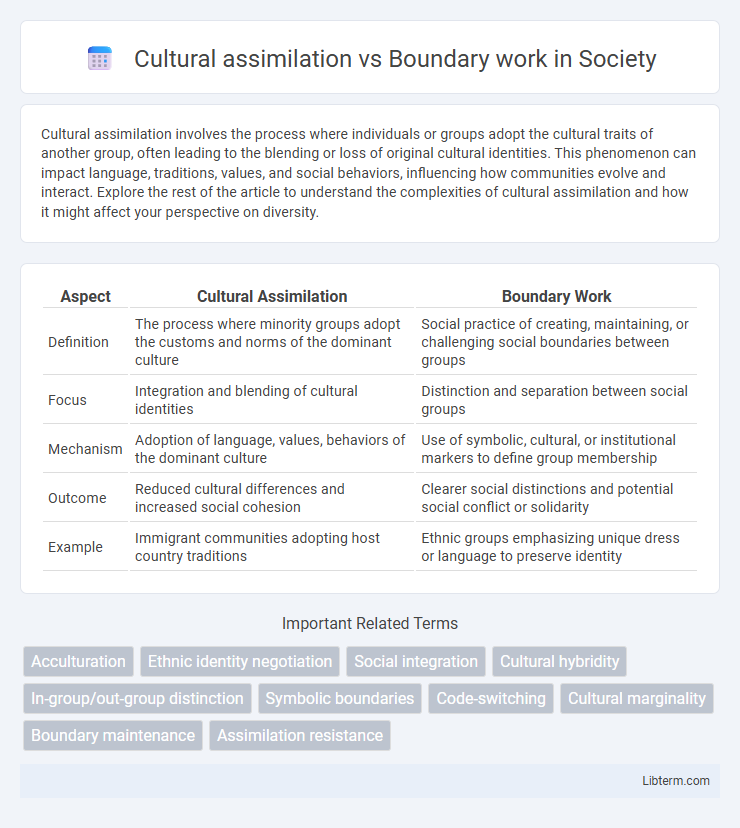Cultural assimilation involves the process where individuals or groups adopt the cultural traits of another group, often leading to the blending or loss of original cultural identities. This phenomenon can impact language, traditions, values, and social behaviors, influencing how communities evolve and interact. Explore the rest of the article to understand the complexities of cultural assimilation and how it might affect your perspective on diversity.
Table of Comparison
| Aspect | Cultural Assimilation | Boundary Work |
|---|---|---|
| Definition | The process where minority groups adopt the customs and norms of the dominant culture | Social practice of creating, maintaining, or challenging social boundaries between groups |
| Focus | Integration and blending of cultural identities | Distinction and separation between social groups |
| Mechanism | Adoption of language, values, behaviors of the dominant culture | Use of symbolic, cultural, or institutional markers to define group membership |
| Outcome | Reduced cultural differences and increased social cohesion | Clearer social distinctions and potential social conflict or solidarity |
| Example | Immigrant communities adopting host country traditions | Ethnic groups emphasizing unique dress or language to preserve identity |
Defining Cultural Assimilation
Cultural assimilation involves the process by which individuals or groups adopt the language, customs, values, and behaviors of a dominant culture, often leading to a diminished or lost original cultural identity. It emphasizes integration into the mainstream society, promoting social cohesion by minimizing cultural differences. This contrasts with boundary work, which actively maintains or negotiates cultural distinctions to preserve unique group identities.
Understanding Boundary Work
Boundary work involves actively defining and maintaining social, cultural, or organizational distinctions that shape group identities and interactions. It contrasts with cultural assimilation by emphasizing the processes through which groups negotiate inclusion or exclusion without fully adopting another culture. Understanding boundary work reveals how power dynamics and identity politics function in multicultural settings to preserve diversity and manage conflict.
Historical Contexts of Assimilation
Historical contexts of assimilation reveal patterns where dominant groups imposed cultural norms to integrate minorities, often erasing indigenous identities through policies like the U.S. Indian Boarding Schools or the Australian Stolen Generations. Boundary work emerges as a response, enabling marginalized communities to maintain distinct cultural markers and resist full absorption by asserting ethnic, linguistic, or religious identities. These dynamics illustrate the tension between homogenizing assimilation efforts and the strategic preservation of cultural boundaries across colonial and post-colonial settings.
Social Mechanisms of Boundary Work
Social mechanisms of boundary work involve practices such as exclusion, symbolic categorization, and identity regulation that create and maintain distinctions between groups within a culture. Unlike cultural assimilation, which implies blending and loss of distinct identities, boundary work emphasizes the active reinforcement of social divides to protect group norms and power structures. These mechanisms are crucial for understanding how social boundaries persist and evolve in multicultural societies.
Key Differences Between Assimilation and Boundary Work
Cultural assimilation involves the absorption of minority groups into the dominant culture, leading to the loss of distinct cultural traits, while boundary work emphasizes maintaining and negotiating social or cultural distinctions to preserve group identity. Assimilation promotes uniformity and integration within a larger society, whereas boundary work reinforces social differentiation through symbolic or practical measures. Key differences lie in assimilation's focus on eroding differences and boundary work's role in constructing and defending boundaries to sustain cultural pluralism.
Impacts on Minority and Majority Groups
Cultural assimilation often pressures minority groups to adopt majority norms, leading to loss of cultural identity and social marginalization, while reinforcing majority group dominance. Boundary work involves active negotiation and maintenance of social distinctions, allowing minority groups to preserve cultural uniqueness but sometimes causing intergroup tensions. Both processes significantly shape power dynamics, social integration, and group identity within multicultural societies.
Case Studies: Assimilation vs Boundary Maintenance
Case studies on cultural assimilation reveal how minority groups adopt dominant cultural norms, often leading to loss of distinct identity, whereas boundary work emphasizes maintaining cultural differences through symbolic practices and social rituals. Research shows assimilation processes in immigrant communities result in language shift and intermarriage, while boundary maintenance is observed in ethnic enclaves preserving traditional customs and resisting integration. The comparative analysis highlights that assimilation promotes homogeneity, while boundary work sustains cultural diversity and group cohesion.
Factors Influencing Assimilation and Boundary Work
Factors influencing cultural assimilation include language proficiency, social networks, and institutional support, which facilitate integration into the dominant culture. Boundary work is shaped by identity maintenance, group solidarity, and perceived discrimination, reinforcing distinctions between groups. Cultural assimilation reduces social boundaries, while boundary work actively preserves or constructs them to manage group differences.
Challenges and Critiques of Both Concepts
Cultural assimilation faces challenges such as the erasure of minority identities and the pressure to conform to dominant norms, which can lead to loss of cultural heritage and social alienation. Boundary work is critiqued for potentially reinforcing social divisions by emphasizing distinctions between groups, sometimes perpetuating exclusivity and conflict. Both concepts struggle with balancing integration and identity preservation, highlighting tensions between social cohesion and diversity acknowledgment.
Future Directions in Cultural Integration and Identity
Future directions in cultural integration emphasize dynamic boundary work that balances preserving distinct identities with promoting shared values and social cohesion. Emerging strategies leverage technology and intercultural dialogue to facilitate adaptive assimilation processes, fostering inclusive environments without eroding cultural uniqueness. Research increasingly advocates for context-sensitive policies that recognize power dynamics and promote equitable identity negotiation in multicultural societies.
Cultural assimilation Infographic

 libterm.com
libterm.com